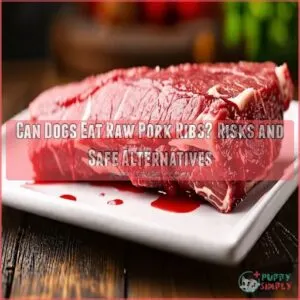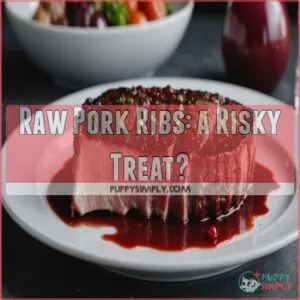This site is supported by our readers. We may earn a commission, at no cost to you, if you purchase through links.
 Thinking about sharing raw pork ribs with your furry friend? You might want to pause.
Thinking about sharing raw pork ribs with your furry friend? You might want to pause.
Raw pork ribs can pose significant risks to your pup due to possible bacterial contamination like Salmonella or E.coli.
Not to mention, there’s the lurking danger of parasites like Trichinella.
Plus, bones can splinter, becoming a serious choking hazard or even causing nasty intestinal blockages.
Why risk your dog’s health when there are far safer options?
How about a tasty and safe alternative like a bully stick or a sturdy chew toy?
Your pooch will appreciate the treat without the trouble—just wait till you see the wag!
Table Of Contents
- Key Takeaways
- Raw Pork Ribs: a Risky Treat?
- Cooked Vs. Raw: The Bone Danger
- Alternatives to Raw Pork Ribs
- Recognizing Signs of Bone Ingestion
- Responding to Bone Ingestion
- Preventing Future Incidents
- Frequently Asked Questions (FAQs)
- Can dogs eat pork ribs?
- Can one eat pork ribs if they have diabetes?
- Can dogs eat raw rib bones?
- Can dogs eat raw pork?
- Are pork rib bones dangerous for dogs?
- Can a grilled pork rib damage a dog?
- Can a dog eat raw pork ribs?
- Are raw rib bones safe for dogs?
- Can I give my dog raw pork bones?
- What do I do if my dog eats raw pork?
- Are pork rib bones ever safe for dogs?
- What about raw pork rib meat, not the bone?
- Can cooked pork ribs be a healthy treat?
- How much cooked pork rib is too much?
- My dog ate a pork rib, should I worry?
- Conclusion
Key Takeaways
- Raw pork ribs pose significant risks to dogs due to potential bacterial contamination from Salmonella and E. coli, and parasites like Trichinella.
- Bones from pork ribs can splinter, creating choking hazards and causing dangerous intestinal blockages or perforations.
- Always choose safer alternatives for your dog, such as bully sticks, durable chew toys, or appropriately sized raw bones like poultry necks and beef knucklebones.
- Supervising your dog with bones and educating family and guests about safe treats can prevent accidents and keep your dog safe.
Raw Pork Ribs: a Risky Treat?
Thinking about giving your dog raw pork ribs?
Be cautious, as they may seem like a tasty treat, but they’re loaded with risks like bacteria and parasites that could harm your furry friend.
Bacterial Concerns (Salmonella, E.coli)
Feeding your dog raw pork ribs might sound tempting, but it’s a risky treat.
The threat of bacterial contamination from Salmonella and E.coli is real. These pesky germs could make your pup sick.
You can explore various alternatives like cooking or buying products from websites like Everysimply.
Feeding your dog always requires prioritizing **
Nutritional Value Vs. Risks
With raw pork ribs, the nutritional value might catch your eye, but weigh the risks carefully.
Sure, there’s protein and calcium, but also high fat and potential allergies.
Dogs eat raw meat, but is it safe? Not quite.
Raw pork ribs dogs love can introduce unwanted companions: bacteria and possibly parasites.
Raw bones benefits? Maybe not worth the gamble.
Choose wisely!
Parasite Risk (Trichinella)
Raw pork ribs can be a parasite playground, often raising eyebrows due to the dreaded Trichinella. Concerned about your pup falling ill? Here’s what you should worry about:
- Trichinella in pork lurks raw.
- Trichinella lifecycle can cause havoc.
- Stick to safe Pork cooking temps.
- Recognize Trichinella symptoms quickly.
- Avoid the raw meat parasite risk altogether!
Cooked Vs. Raw: The Bone Danger
Regarding feeding bones to your dog, the choice between cooked and raw is more critical than you might think.
Cooked bones can splinter easily and pose a choking hazard, while raw bones might carry bacteria, turning a treat into a stomach-turning adventure.
Splintering and Choking Hazards
So, you’ve considered the bacterial risks of raw pork ribs.
Now, let’s talk bone danger!
Cooked bones are far more likely to splinter into dangerous shards.
Raw bones, while safer, still pose a choking hazard.
Always supervise your dog.
| Bone Type | Cooked Risk | Raw Risk | Safe Alternative? |
|---|---|---|---|
| Pork Ribs | Very High | High | No |
| Chicken Bones | High | Medium | Yes (with caution) |
| Beef Bones | High | Low | Yes |
| Bully Sticks | None | None | Yes |
Remember, responsible bone choices and constant supervision are key to keeping your furry friend safe.
Proper bone disposal prevents future accidents.
Intestinal Blockages and Perforations
Imagine your dog, happily chewing away, unaware of the lurking danger.
Splintered bones can also lead to intestinal blockages and perforations, posing serious health risks.
Watch for these symptoms:
- Vomiting and diarrhea, indicating dog digestive problems.
- Abdominal pain, showing possible blockages.
- Lethargy, a sign of internal issues.
Prevention is key to avoiding emergency treatment or surgery.
Safe Cooking Methods for Pork
After addressing the challenges of intestinal blockages, let’s explore cooking pork safely.
Make sure an internal temperature of 145°F to prevent hazards.
You can find a variety of products for safe preparation, such as a raw pork rib dog, to help ensure proper cooking.
Utilize a safe thermometer for accuracy.
Different pork cuts require specific cooking time:
| Pork Cut | Cooking Time |
|---|---|
| Chops | 7-8 mins/side |
| Tenderloin | 20-30 mins |
| Ribs | 3-4 hours |
| Ground Pork | 15 mins |
| Shoulder Roast | 6-8 hours |
Cooked bones crack less, sparing your pup from splinters!
Alternatives to Raw Pork Ribs
When you’re considering treats for your dog, raw pork ribs mightn’t be the safest bet, but there are plenty of great alternatives to keep your pup happy and healthy.
From safe raw bones like poultry and beef to easily digestible commercial chews and fun chew toys, you’ve got lots of options for your furry friend.
Safe Raw Bones (Poultry, Beef)
Chewing on raw bones can provide your dog with natural dental benefits, unlike their cooked counterparts that might splinter.
However, you should choose the right type of bones, as some like raw pork bones pose a choking hazard.
Opt for safe raw bones like poultry necks and beef knucklebones, which are less likely to cause issues.
Bone selection tips
Commercially-Available Chews (Bully Sticks, Antlers)
Switching from safe raw bones, you’ll find lots of chewy fun in commercially available options like bully sticks and antlers.
These also curb that insatiable urge to chew but also come with added benefits:
- Bully stick alternatives: Safer for digestion compared to rawhide.
- Antler durability: Long-lasting chews for even the toughest chompers.
- Chew safety: Helps keep those pearly whites clean and healthy.
Safe Chew Toys
Bully sticks not enough for your pup? Safe chew toys are excellent alternatives.
Opt for those made from durable materials like rubber or nylon, chosen for your dog’s size and chewing habits.
Regular toy rotation keeps them engaged.
While raw pork ribs are tempting, these toys protect teeth and prevent hazards.
Think of it as a safety net for your furry friend’s fun!
Recognizing Signs of Bone Ingestion
Knowing what to watch for is key.
If your dog’s swallowed a bone, you might notice vomiting, diarrhea, or a sudden lack of energy and appetite—think of it like when you’re feeling under the weather.
Vomiting and Diarrhea
Your pup’s upset stomach might’ve you suspicious of bone ingestion, causing vomiting and diarrhea. These symptoms can indicate more serious dog digestive issues.
- Frequent vomiting: A warning bell.
- Loose stools: Not just a messy problem.
- Dehydration: A real threat.
- Dietary changes: Temporary relief.
Worry when symptoms don’t resolve or worsen quickly.
Lethargy and Loss of Appetite
If your dog gobbles up bones, watch for lethargy and loss of appetite.
It’s like their body’s flashing a caution sign, warning of potential trouble.
Consuming bones like pork shoulder bones can lead to severe digestive issues, including bone ingestion problems.
Raw pork ribs might seem harmless, but bone ingestion can affect dog health, leading to
Changes in Behavior
Noticing your pup’s lethargy leads naturally to another sign—changes in behavior.
Watch for signs like anxiety, aggression, restlessness, or hiding.
These behaviors might hint at discomfort related to raw bones risks.
Even tiny bone fragments could cause depression and weird conduct.
Use these signals to understand your pet better, ensuring their habits stay as unruffled as a calm pond.
Responding to Bone Ingestion
If your dog decides to channel its inner wolf and gobbles down a bone, knowing when to hit the panic button is very important.
Keep an eye on them like they’re sneaky toddlers, and be ready to call the vet or provide some home comfort with a bland diet if needed.
When to Seek Immediate Veterinary Care
Spotting signs like excessive vomiting or blood in stool can raise red flags, and it’s important to remember that intestinal perforation risks from sharp bone fragments can lead to life-threatening complications.
When difficulty breathing or abdominal swelling join the scene, drop everything and call the vet—like, yesterday!
Dogs can’t just shake off loss of consciousness or suspicious bone
Home Care (Bland Diet, Monitoring)
You realize your furry friend might’ve chewed on mind-bogglingly sharp pork ribs, now what?
Introduce a bland diet to soothe their tummy and keep an eagle eye for issues.
Key tips:
- Switch to chicken and rice mix
- Monitor for vomiting and diarrhea
- Note any lethargy or behavior changes
- Reach out if your pet isn’t improving
Potential Veterinary Interventions (Surgery, X-rays)
Should your dog need emergency surgery for bone ingestion, prepare for significant X-ray costs and potential Bone removal procedures.
Post-op care is essential for a successful recovery timeline.
Checking a Dog Bone Size Chart will help you avoid choosing the wrong bone size.
Remember, preventing bone ingestion is key!
Choosing appropriate raw bones for dogs, like raw meaty bones, over cooked bones, is important.
Always
Preventing Future Incidents
To keep your furry friend safe from risky rib-related mishaps, you’ll want to pick the right bones and always watch over them while they chew.
Safe chew toys and regular rotation are crucial for keeping your dog entertained.
Educate your family and guests about safe chew toys and rotate them regularly, so there’s never a dull moment for your dog—or you!
Responsible Bone Selection and Supervision
If you’re thinking about giving your dog bones, raw pork ribs aren’t a good idea.
Consider bone size, chew strength, and your dog’s breed.
By selecting safe bones for dogs, you’ll avoid accidents.
Always supervise with care, as even the best choices can lead to trouble without attention.
After all, you’re your pup’s best guardian!
Safe Chew Toy Options and Rotation
Chew toys are a lifesaver for dogs.
Prioritize toy safety with these tips:
- Rotation schedule keeps toys exciting and prevents wear.
- Opt for durable materials to avoid pieces breaking off.
- Maintain a regular cleaning routine to keep germs at bay.
A safe chew option beats raw bones anytime, giving you peace of mind and your pup hours of fun.
Educating Family Members and Guests
Imagine this: you’re hosting a barbecue, and friends unknowingly toss raw pork ribs to your dog.
To avoid this bone safety blunder, chat with guests about proper dog food basics and responsible pet ownership during these gatherings.
Highlight safe alternatives for treats, like chew toys or bone-safe snacks.
With a little heads-up, everyone learns guest etiquette—keeping Fido safe and happy.
Frequently Asked Questions (FAQs)
Can dogs eat pork ribs?
Balancing your love for your pup and their safety, cooked pork ribs without bones or spices can be an occasional treat.
Avoid raw ribs and bones entirely, as they pose splintering and choking hazards to your furry friend.
Can one eat pork ribs if they have diabetes?
If you have diabetes, you can eat pork ribs in moderation.
Focus on portion control and balance them with veggies and whole grains.
It’s important to avoid sugary sauces and consult your doctor for personalized advice.
Can dogs eat raw rib bones?
Imagine your dog as a curious explorer, sniffing out hidden dangers.
Raw rib bones can be risky, splintering into sharp shards that harm your furry friend’s mouth or insides.
Always pick safer, larger bones and supervise chewing.
Can dogs eat raw pork?
Feeding your dog raw pork isn’t the best idea.
Raw pork can contain harmful bacteria and parasites, like trichinella, which can make them sick.
It’s safer to cook the pork thoroughly before offering it as a treat.
Are pork rib bones dangerous for dogs?
You might think pork rib bones are okay for dogs, but they’re actually dangerous.
These bones can splinter, leading to choking or internal injuries.
Always keep your furry friend safe by avoiding giving them pork rib bones.
Can a grilled pork rib damage a dog?
Grilled pork ribs can harm your dog because the bones might splinter and cause injuries.
Bones can break teeth, choke, or block intestines.
Always remove bones and seasonings before sharing meat to keep your pup safe.
Can a dog eat raw pork ribs?
Imagine this: Raw pork ribs aren’t ideal for your pup.
They can harbor bacteria, and bones might splinter, causing internal damage.
Stick to cooked, boneless meat, given as an occasional treat.
Always consult your vet!
Are raw rib bones safe for dogs?
Raw rib bones can pose a risk to your dog, as they might splinter or cause choking.
It’s best to opt for safer alternatives like large marrow bones, and always supervise your furry friend while chewing.
Can I give my dog raw pork bones?
Think of bones as nature’s chewy toys; raw pork bones can be risky for dogs.
They may splinter, causing injury or infection.
Always consult your vet first, ensuring your furry friend stays wagging and healthy.
What do I do if my dog eats raw pork?
If your dog eats raw pork, keep an eye out for symptoms like vomiting or diarrhea.
Contact your vet immediately for advice, as raw pork can carry parasites.
Remember, better safe than sorry!
Watch them closely.
Are pork rib bones ever safe for dogs?
Pork rib bones aren’t safe for dogs as they can splinter into sharp pieces, posing choking or injury risks.
Even raw versions are hazardous.
Always choose large, raw bones, like knucklebones, suitable for your dog’s size.
What about raw pork rib meat, not the bone?
Around 297 calories are in 5 ounces of pork, packing a protein punch dogs love.
Avoid raw meat to steer clear of nasty bacteria.
Always cook it well and skip those seasoning shenanigans for safety.
Can cooked pork ribs be a healthy treat?
Cooked pork ribs can make a tasty treat for your dog, but make sure the meat is plain, fully cooked, and free of bones and seasonings.
Offer in moderation, since too much fat might upset your pup’s stomach.
How much cooked pork rib is too much?
Did you know that 20% of dog owners give their pups table scraps?
For your dog, a little cooked pork rib is fine, but too much fat can upset their tummy.
Keep it to a small treat, and watch for any issues.
My dog ate a pork rib, should I worry?
Keep an eye on your dog if it ate a pork rib bone, as it could splinter and cause problems.
Watch for signs like choking, vomiting, or discomfort.
Contact your vet if you notice anything unusual.
Conclusion
Offering raw pork ribs to your dog isn’t just risky, it’s potentially dangerous.
Bacterial threats, like Salmonella and E. coli, can make your pup very sick.
Parasites are also a concern, all while bones pose choking and blockage risks.
Why gamble with such hazards?
Instead, opt for safer, healthier alternatives like bully sticks or chew toys.
Your dog won’t miss the trouble, just revel in the joy of a safe treat.
Keep the wagging tails going strong!











